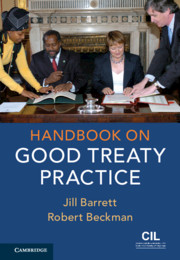Book contents
- Handbook on Good Treaty Practice
- Reviews
- Centre for International Law, National University of Singapore (CIL-NUS)
- Handbook on Good Treaty Practice
- Copyright page
- Contents
- Contents
- Figures
- Boxes
- Acknowledgements
- Table of Cases
- Table of Treaties and other International Instruments
- Table of Legislation
- Abbreviations
- 1 Introduction to Good Treaty Practice
- 2 Organising Treaty Work in Governments and International Organisations
- 3 Treaties and Other Kinds of International Instruments
- 4 Managing and Using Treaty Collections
- 5 Making a New Treaty: Negotiation, Drafting and Production
- 6 Preparing to Become Party to a Treaty
- 7 Becoming Party to a Treaty: Consent to Be Bound and Entry into Force
- 8 Continuing Engagement with the Treaty Throughout Its Life
- 9 Ending Treaty Relations
- 10 The Future of Treaty Practice
- Annexes
- Glossary
- Suggested Further Reading
- Index
6 - Preparing to Become Party to a Treaty
Published online by Cambridge University Press: 27 January 2020
- Handbook on Good Treaty Practice
- Reviews
- Centre for International Law, National University of Singapore (CIL-NUS)
- Handbook on Good Treaty Practice
- Copyright page
- Contents
- Contents
- Figures
- Boxes
- Acknowledgements
- Table of Cases
- Table of Treaties and other International Instruments
- Table of Legislation
- Abbreviations
- 1 Introduction to Good Treaty Practice
- 2 Organising Treaty Work in Governments and International Organisations
- 3 Treaties and Other Kinds of International Instruments
- 4 Managing and Using Treaty Collections
- 5 Making a New Treaty: Negotiation, Drafting and Production
- 6 Preparing to Become Party to a Treaty
- 7 Becoming Party to a Treaty: Consent to Be Bound and Entry into Force
- 8 Continuing Engagement with the Treaty Throughout Its Life
- 9 Ending Treaty Relations
- 10 The Future of Treaty Practice
- Annexes
- Glossary
- Suggested Further Reading
- Index
Summary
The chapter concerns steps to consider in preparing to become party to a treaty. It examines the eligibility of States and IOs to participate in multilateral treaties, including scenarios in which eligibility to join a treaty is not clear and what procedures may be used to resolve such issues. The chapter explains the importance of understanding ‘modes of expressing consent to be bound’, and choosing the appropriate mode. It looks at how a treaty may be made by exchange of instruments. Lastly, the chapter considers internal preparations to give consent to be bound for States and IOs, including consultations with stakeholders.
Keywords
- Type
- Chapter
- Information
- Handbook on Good Treaty Practice , pp. 203 - 243Publisher: Cambridge University PressPrint publication year: 2020

